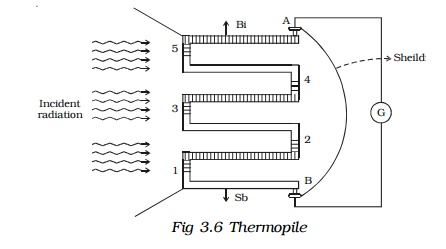Chapter: physics 11th 12th standard school college definition answer assignment examination viva question
Thomson effect and Thomson coefficient (σ)

Thomson effect
Thomson suggested that when a current flows through unequally heated conductors, heat energy is absorbed or evolved throughout the body of the metal.

Consider a copper bar AB heated in the middle at the point C and current flowing as shown in Fig. 3.5a. When no current is flowing, the point M and N equidistant from C are at the same temperature. When current is passed from A to B. N shows higher temperature compared to M. Similarly, B will show higher temperature as compared to A. It means from A to C heat is absorbed and from C to B heat is evolved. This is known as positive Thomson effect. Similar effect is observed in the case of Sb, Ag, Zn, Cd, etc. When the current is passed from B to A, M will show higher temperature as compared to N.
In the case of Iron (fig. 3.5b), when it is heated at the point C and current is flowing from A to B, M shows higher temperature as compared to N. It means from A to C, heat is evolved and from C to B heat is absorbed. This is negative Thomson effect. Similar effect is observed in the case of Pt, Bi, Co, Ni, Hg, etc.
If we take a bar of lead and heat it at the middle point C, the point M and N equidistant from C show the same temperature when current is flowing from A to B or from B to A. Therefore, in the case of lead, Thomson effect is nil. Due to this reason, lead is used as one of the metals to form a thermo couple with other metals for the purpose of drawing thermo electric diagrams.
Thomson coefficient (σ)
The amount of heat energy absorbed or evolved when one ampere current flows for one second (one coulomb) in a metal between two points which differ in temperature by 1oC is called Thomson coefficient. It is denoted by σ. Its unit is volt per oC.
Related Topics